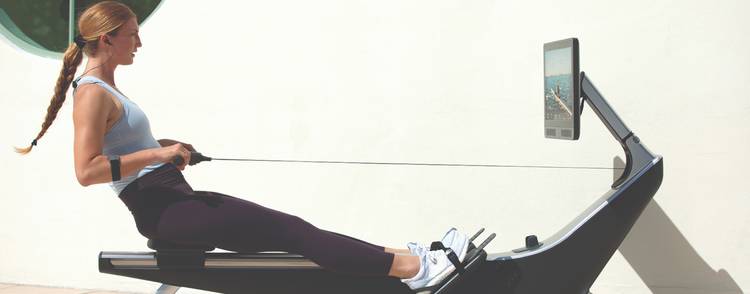
Water Rower VS Air Rower: A Complete Guide
Which Rowing Machine Do You Need?
If you��’re thinking of rowing at home, the question you should be asking yourself is, which type of rowing machine do you need? The different types are primarily distinguished by the type of resistance used. There are air, magnetic, water, and hydraulic rowing machines.
However, the important consideration is water rower vs air rower machines since they are the most popular types primarily. They are mechanically simple and fall within an affordable mainstream price range.
WaterRower Machines
It seems intuitive that a machine simulating a rowing exercise would use water, but that is not all there is to water rowing.
The build and physics of water rowers are very simple. The general layout is very similar to other types of rowing machines. They have long seat rails, footplates, and handles.
Inside the tank are pedals that are freely suspended from a central pivot point. The pedals are spun with every pull of the handle by a rowing strap through a 1:1 drive system.
As you row faster, more water is displaced, increasing the drag resistance. Water rowing machines don’t have a resistance adjustment as such. Instead, the rower’s speed determines the machine’s resistance. The rule of cubes defines this concept.
Thus, doubling the speed of a boat increases the drag resistance by a factor of eight.
In the machine’s case, the water simulates the weight of the boat. You can adjust the water level in the machine to change the feel of the strokes.
More water makes the strokes heavier, and less water lightens the strokes. However, this doesn’t change the amount of work done on the machine.
Air Rowers
Both air and water rowers are dependent on fluid resistance. The physics is similar, except that in air rowers, a fan flywheel in an enclosure replaces the water tank in a water rower. Also, the flywheel in an air rower is higher on the rowing platform because it is lighter than a water tank.
The flywheel is driven by a 1:1 transfer configuration via a rowing strap. The fins of the fan are aligned in such a way to cause drag with the surrounding air while spinning. Pulling on the handle turns the flywheel causing drag with the air in the enclosure.
This translates to pull resistance.
With the air rower, the faster you row, the more resistance you face. The resistance operation is the same as in water rowing because the laws of fluid dynamics are constant.
The equivalent of adjusting the water level in an air rower is changing the dumper settings. Dampers allow a specific amount of air to interact with the fan. More air means heavier strokes.
Water Rower Vs Air Rower: What are the Differences?
You might argue that since both machines basically serve the same purpose and work roughly in the same way, it would be nitpicking to tell them apart. Yes, they do work in the same way for the same workout exercises, but as fitness enthusiasts will tell you – they are very different machines.
Let’s look at some of the ways in which water rowers are different from air rowers.
1. Price
Price is a significant factor when it comes to the choice of home fitness equipment. Water rowing machines tend to be on a higher piece range than air rowers. The construction and power transfer are a little bit more complicated compared to air rowers.
For this reason, air rowers are a more popular selection.
2. Noise
If noise is an issue, then the better option is a water rower. Air rowers are much louder than water rowers; they make a gushing fan noise with every stroke.
The splashing and whooshing noise from a water rower is much softer. Some even claim it’s comforting and soothing.
3. Size
Water rowers are larger and heavier than air rowers due to the extra size and weight of the tank. With their lightweight construction, air rowers come with various convenient storage features, such as folding and removable components.
4. Rowing Experience
Water rowers have a smooth, consistent resistance throughout the entire stroke. Air rowing can feel a bit turbulent but not enough to spoil the experience. This has to do with the thicker consistency of water as a fluid.
Both machines provide a smooth operating action, and most users can never tell the difference in the strokes. However, water rowers have a strong catch at the start that lightens smoothly as the stroke finishes. Conversely, air rowers feel lighter at the beginning and heavier at the finish.
5. Monitors
Although you can get pretty decent workout monitors on both types of machines, an air rower’s monitor will be more equipped and accurate. Professional athletes prefer the calibration and parameters measured on air rowers to those on water rowers.
If accurate workout tracking data such as rowing speed, stroke time, forces and split time matter to you, then an air rower is the better product.
Which One Wins
So, water rower vs air rower, which one wins?
Well, it mostly comes down to a matter of preference. Both are proper workout equipment for intense cardio exercises, and none of them tips the scales far enough in favour of the other to that effect.
If you are still undecided on whether to get a water rower or an air rower, get in touch with us for more information about rowers and, indeed, any other fitness equipment. We proudly specialize in delivering quality workout products from world-leading brands.







